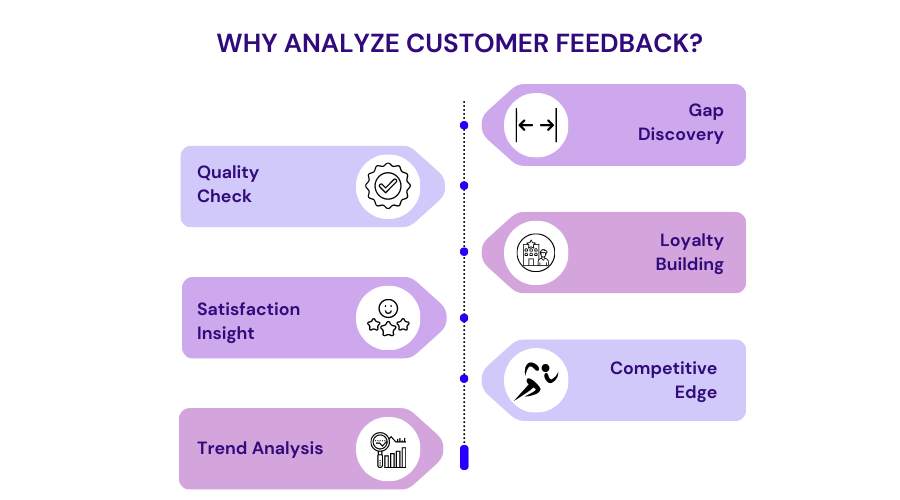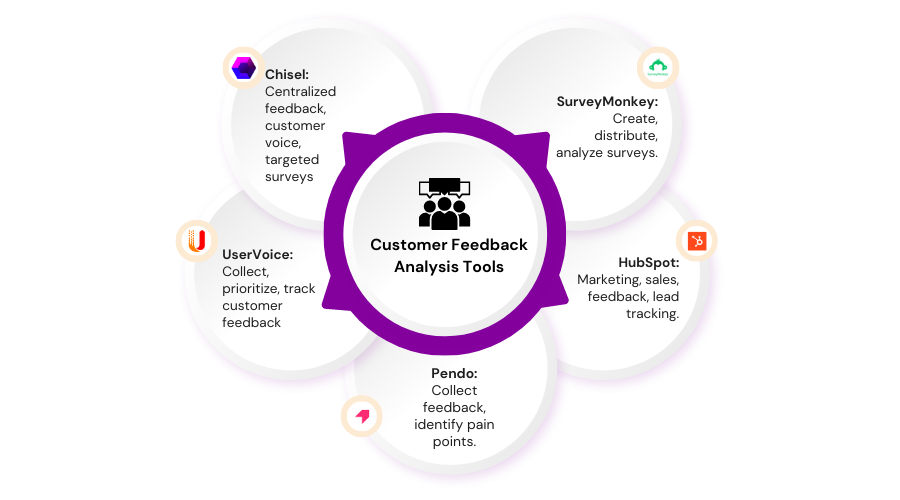Mastering Customer Feedback Analysis: Tips and Tools

Welcome to the world of customer feedback analysis, where insights and success lie hidden within the valuable opinions of your customers. In today’s competitive landscape, understanding your customers’ thoughts and experiences is crucial for thriving in the market. Customer feedback analysis is the art and science of extracting actionable intelligence from customer feedback data to drive business growth and improve customer satisfaction.
At its core, customer feedback analysis involves systematically collecting, organizing, and analyzing feedback from various sources, such as surveys, reviews, social media, and support tickets. This treasure trove of information holds the key to unlocking valuable insights about your products, services, and overall customer experience.
By leveraging advanced analytics techniques and innovative tools, you can transform this raw feedback into meaningful patterns, trends, and sentiment analysis. Unveiling what your customers truly desire, this process empowers you to make data-driven decisions, identify areas for improvement, and ultimately enhance your offerings to meet and exceed customer expectations.
So get ready to set out on a journey where customer feedback analysis serves as your secret weapon for success in the ever-changing business environment and where client voices serve as your compass.
Why Should You Analyze Customer Feedback?

Analyzing customer feedback is crucial for several reasons.
Enhance Product and Service Quality
Analyzing customer feedback enables you to gain valuable insights into the strengths and weaknesses of your products and services. By comprehending customer preferences and criticisms, you can pinpoint areas that require enhancement and implement necessary adjustments.
Improve Customer Satisfaction
Listening to customer feedback and taking it into account demonstrates that you value their opinions and care about their experience.
Actively analyzing their feedback and implementing improvements based on their suggestions enhances customer satisfaction. Satisfied customers are more inclined to become loyal, repeat patrons and advocate for your business, thereby fostering long-term success.
Identify Trends and Patterns
Analyzing customer feedback allows you to identify recurring themes, trends, and patterns in their preferences and behaviors.
By understanding these patterns, you can proactively address customer concerns and make informed business decisions. This knowledge lets you stay ahead of changing market trends and adapt your products or services accordingly, ensuring continued customer satisfaction.
Identify Gaps and Opportunities
Customer feedback often contains valuable suggestions or expresses unmet needs. By analyzing this feedback, you can identify gaps in your product offerings or discover new growth opportunities.
Understanding customer demands and expectations enables you to expand your product line, introduce new features, or target specific customer segments, enhancing your overall business strategy.
Foster Customer Loyalty
Actively seeking and analyzing customer feedback demonstrates a commitment to continuous improvement. By actively analyzing customer feedback, you cultivate a sense of trust among your customer base. They perceive that you genuinely value their opinions and are dedicated to giving customers the greatest experience.
Loyal customers are more probable to stay with your brand, advocate for your business, and contribute positively to your reputation and growth.
Gain a Competitive Advantage
Analyzing customer feedback can provide you with a competitive edge. By understanding what customers appreciate about your competitors’ products or services, you can identify areas where you can differentiate yourself and offer a superior customer experience.
Through consistently addressing customer feedback, you can build a reputation for being responsive to customer needs. This sets you apart from your competitors and attracts more customers to your business.
What Makes Customer Feedback Analysis a Complex Task?
Customer feedback analysis is crucial for businesses aiming to improve their products and services. Nevertheless, it is a complicated process that involves various challenges.
In this article, we will explore the key factors contributing to the complexity of customer feedback analysis.
Vast Amount of Data
Customer feedback can come from various sources, such as surveys, social media, online reviews, and customer support tickets. These sources create a lot of data, which can be overwhelming, making it difficult to process and analyze the information manually.
Unstructured Nature of Feedback
Customer feedback often gets expressed in unstructured formats like free-text comments, tweets, or online reviews. These unstructured forms lack a standardized structure or predefined categories, making it challenging to extract meaningful insights. Natural language processing (NLP) techniques are required to parse and make sense of this unstructured data.
Subjectivity and Context
Customer feedback is subjective, as it reflects individual opinions and experiences. Accurately analyzing feedback requires understanding the context.
The sentiment expressed by a customer may vary depending on their expectations, previous experiences, or cultural background. Interpreting feedback accurately requires considering these subjective factors.
Noise and Irrelevant Information
Not all feedback is valuable or relevant for analysis. Noise in the form of spam, unrelated comments, or duplicate entries can obscure valuable insights. Identifying and filtering out irrelevant information is a challenge, as it requires a combination of automated algorithms and human judgment to ensure the quality and accuracy of the analysis.
Multi-lingual and Multimodal Feedback
In a globalized world, businesses receive feedback in multiple languages. Analyzing customer feedback in different languages adds additional complexity to the process.
Moreover, you can provide feedback in various formats, including text, images, audio, and video. Analyzing multimodal feedback, which combines different forms of media, presents unique challenges in processing and understanding the content accurately.
Sentiment Analysis and Emotion Detection
Analyzing the sentiment expressed in customer feedback is critical to understanding customer satisfaction or dissatisfaction. Sentiment analysis techniques identify positive, negative, or neutral sentiments. Additionally, detecting emotions expressed in feedback, such as anger, frustration, or happiness, can provide deeper insights.
However, accurately identifying sentiment and emotions from text or other forms of feedback can be a complex task due to language nuances and sarcasm or irony.
Steps for Conducting Customer Feedback Analysis
We shall outline the procedures for customer feedback analysis.
Data Collection
The first step is to gather customer feedback from various sources. For example, surveys, social media platforms, online reviews, customer support tickets, and feedback forms. Collect data from diverse channels to obtain a comprehensive view of customer opinions.
Data Cleaning and Preparation
Once the feedback data is collected, cleaning and preparing it for analysis is necessary. It involves removing irrelevant or duplicate entries, standardizing the data format, and addressing missing values or inconsistencies. Data cleaning ensures the accuracy and reliability of the analysis.
Categorization and Labeling
It is essential to categorize and label it based on relevant themes or topics to make sense of the feedback. This step involves identifying common patterns, keywords, or phrases in the feedback data and creating categories or tags to group similar feedback. Categorization simplifies the analysis process and allows a more structured examination of customer sentiments.
Sentiment Analysis
Sentiment analysis is a crucial component of customer feedback analysis. It involves determining the polarity of customer opinions, whether positive, negative, or neutral. Automated sentiment analysis tools or natural language processing techniques help you to analyze the sentiment expressed in the feedback. This step provides insights into overall customer satisfaction levels.
Identify Key Insights
After sentiment analysis, the next step is identifying key insights from the analyzed feedback. It involves examining the feedback data’s patterns, trends, and recurring themes. Look for common issues, suggestions, or positive feedback that can inform decision-making and drive improvements in products, services, or customer experiences.
Quantitative Analysis
In addition to sentiment analysis, it can be beneficial to perform a quantitative analysis of the feedback data. It includes calculating metrics such as customer satisfaction scores, Net Promoter Score (NPS), or sentiment distribution across different segments or periods. Quantitative analysis provides a numerical perspective and helps measure customer feedback’s impact on business performance.
Actionable Recommendations
Depending on the insights gained from the analysis, formulate actionable recommendations for improvement. These recommendations should be specific, measurable, achievable, relevant, and time-bound (SMART). They should address the identified issues, capitalize on positive feedback, and align with the business objectives.
Monitor and Iterate
Customer feedback analysis should be an ongoing process. Continuously monitor and track feedback to identify any changes or emerging trends. Regularly iterate on the analysis methodology and refine the categorization, sentiment analysis, or metrics used to ensure the analysis remains relevant and accurate over time.
Tools and Techniques for Customer Feedback Analysis
Various tools and techniques help you to analyze and extract valuable insights from customer feedback. Here are some commonly used tools and techniques in customer feedback analysis:
Sentiment analysis
Sentiment analysis is a technique that involves determining the sentiment or emotional tone expressed in customer feedback. It employs natural language processing (NLP) algorithms to classify feedback as positive, negative, or neutral. Sentiment analysis helps identify trends, customer sentiments, and areas of improvement.
Text mining and Text Analytics
Text mining techniques involve extracting valuable information from unstructured customer feedback data.
It includes methods like text categorization, topic modeling, and entity extraction. Text analytics tools aid in analyzing large volumes of textual data and identifying patterns, themes, and emerging issues.
Surveys and Questionnaires
Surveys and questionnaires are practical tools for collecting structured customer feedback. They provide specific questions or rating scales to gather quantitative data. Statistical analysis can help you perform survey responses to uncover trends, correlations, and customer preferences.
Social Media Monitoring
Social media platforms provide a wealth of customer feedback through posts, comments, and reviews. Social media monitoring tools enable tracking and analyzing customer sentiments and discussions about a brand, product, or service. It helps identify brand advocates, detect potential issues, and measure brand perception.
Customer Feedback Management Systems
These systems collect and store customer feedback from various channels, such as email, chat logs, surveys, and social media. They provide a centralized repository for feedback data and often include features like sentiment analysis, reporting, and visualization.
Customer Journey Mapping
Customer journey mapping helps visualize and understand the customer’s experience at various touchpoints with a product or service. By analyzing customer feedback at different stages of the journey, businesses can identify pain points and areas of improvement and enhance overall customer satisfaction.
Customer Feedback Forums and Online Communities
Online forums and communities dedicated to specific products or industries can be valuable sources of customer feedback. Monitoring and actively participating in these platforms enable businesses to gather insights, address customer concerns, and foster engagement.
Data Visualization
Data visualization tools assist in transforming customer feedback data into visual representations. Examples of visual representations are charts, graphs, and heat maps. These visualizations simplify the identification of patterns, trends, and correlations in the feedback, enabling stakeholders to swiftly grasp insights.
Customer Feedback Analytics Platforms
There are specialized platforms available that offer comprehensive customer feedback analysis capabilities. These platforms combine multiple tools, techniques, and analytics capabilities to provide advanced insights into customer sentiments, preferences, and behavior.

Leveraging Artificial Intelligence to Enhance Feedback Analysis
Artificial Intelligence (AI) has revolutionized various industries, and customer feedback analysis is no exception. Utilizing the potential of AI, companies can extract deeper insights, uncover hidden patterns, and enhance the accuracy and efficiency of feedback analysis.
Let’s explore how AI can help you enhance feedback analysis, breaking it down into subheadings:
Sentiment Analysis: Unveiling the Emotional Tone
AI-powered sentiment analysis algorithms can accurately determine the emotional tone expressed in customer feedback.
These algorithms analyze the text, considering linguistic nuances, context, and even sarcasm. By automatically classifying feedback as positive, negative, or neutral, businesses can gain a comprehensive understanding of customer sentiments at scale.
Natural Language Processing (NLP): Understanding the Customer Voice
NLP techniques enable AI systems to understand and interpret human language, making extracting valuable insights from customer feedback easier. Through NLP, businesses can identify key topics, themes, and entities mentioned in the feedback.
Additionally, NLP can help categorize feedback, identify trends, and detect emerging issues, providing a more holistic view of customer preferences and concerns.
Text Mining and Text Analytics: Unearthing Hidden Insights
AI-driven text mining and text analytics techniques delve into unstructured customer feedback data, unveiling hidden insights.
By automatically categorizing feedback, identifying recurring topics, and extracting meaningful information, businesses can prioritize areas of improvement and align their strategies accordingly. These techniques bring structure and depth to the analysis, empowering organizations to make data-driven decisions.
Machine Learning: Uncovering Patterns and Trends
Machine learning algorithms can help you analyze vast amounts of customer feedback data to identify patterns, trends, and correlations. AI systems can predict future customer behavior and preferences by training models on historical feedback.
These insights enable businesses to proactively address customer needs, personalize experiences, and optimize their offerings for maximum customer satisfaction.
Voice and Speech Analytics: Capturing Verbal Feedback
In addition to written feedback, AI-powered voice and speech analytics can analyze verbal feedback. By transcribing and analyzing customer calls or recorded interactions, businesses can gain insights into customer sentiment, identify pain points, and improve customer service. Voice analytics also allows for sentiment analysis, topic extraction, and keyword spotting, providing a comprehensive understanding of customer feedback across different channels.
Real-time Monitoring and Alerting: Addressing Issues Instantly
AI-driven feedback analysis systems can monitor customer feedback in real time, providing businesses with immediate insights into customer sentiments and emerging issues.
By setting up automated alerts for specific keywords or sentiment shifts, organizations can promptly address customer concerns, resolve issues, and prevent potential crises. Real-time monitoring empowers businesses to stay proactive and responsive to customer needs.
Personalization and Recommendation Systems: Tailoring the Customer Experience
AI-based recommendation systems leverage customer feedback to provide personalized suggestions and recommendations. By analyzing feedback data, customer preferences, and past interactions, these systems can offer tailored product recommendations, content suggestions, or customized offers.
This level of personalization enhances the customer experience, fosters loyalty, and drives customer satisfaction.
Conclusion
In a world driven by customer satisfaction, analyzing their feedback holds the key to unlocking success. Customer feedback analysis is no simple feat, but armed with the right tools and techniques, it becomes a pathway to invaluable insights.
By delving into the realm of customer sentiment and preferences, businesses can uncover hidden treasures that guide their growth.
So, why settle for mere speculation when the power of data can elevate your understanding? Embrace the art of customer feedback analysis, and watch as your organization flourishes through a deeper connection with its audience.
The path to success starts with listening, understanding, and transforming feedback into action.
